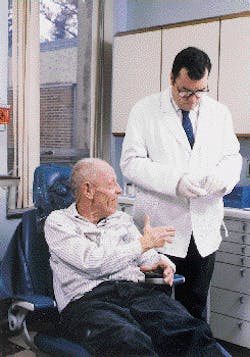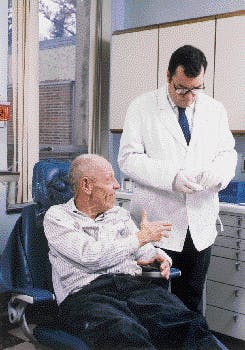Power-assisted toothbrushes simplify hygiene for those who need extra help
Joseph M. Finizio, DDS,
Daniel W. Fox, RDH,
Dona Stevens Yasser
Individuals who are developmentally disabled on multiple levels require optimum oral care, but they also present a treatment challenge. Traditionally, these patients, who reside in group settings, are provided preventive dentistry through periodic prophylaxes, and they receive direct oral hygiene or supervised instruction twice daily.
They use manual brushes and toothpaste as a standard method of oral hygiene. The hygiene is rendered by the direct-care staff, who may actually brush the patients` teeth or otherwise provide hands-on assistance.
Unique circumstances affecting oral hygiene for these patients include:
- Limited patient comprehension and dexterity.
- Resistance to treatment.
- Varying experience and technique of direct-care personnel.
- General health of the patient.
As a result, treatment may be complicated, and the oral-hygiene levels of these patients may fluctuate. Subsequently, they may typically present with chronic conditions in the oral cavity, ranging from simple gingivitis to severe periodontitis.
These inherent inconsistencies in oral hygiene need to be addressed. The goal is to deliver satisfactory, uniform care that would maintain optimum oral health among patients of all disability levels.
With this obective in mind, the dental department at the New Lisbon, N.J., Developmental Center initiated a long-range, advanced oral-hygiene plan in 1990. The New Lisbon Developmental Center is a 722-bed state agency, fully certified as an intermediate care facility. The facility is committed to empowering its developmentally-disabled population to perform functional activities which enhance the quality of life.
The oral-hygiene plan outlined instruction programs for staff and patients and incorporated power-assisted toothbrushes. In regards to the latter, the staff searched for a device with a wide handle that was easier to grasp and manipulate - both for those patients capable of using the instrument independently and for staff members delivering the oral care to patients.
Before implementing the program, able patients and staff were given daily instructions in using power-assisted toothbrushes. They were instructed on how to effectively place the brush to clean all areas of the teeth. A written instructional guide in daily oral health care with the power-assisted toothbrush was also handed out. The center`s care staff was given instructions for all levels of developmental disabilities and physical handicaps.
After exams and routine prophylaxis treatment, the patients began participating in the program. The program was monitored to ensure understanding and comfort. A registered dental hygienist evaluated the oral-health status of participating patients on a quarterly basis. The patient status was determined by using the Simplified Oral Hygiene Index (OHI-S) by Green and Vermilion.
Statistics confirm advanced care works
The 10 patients in the first group showed enough significant improvement in oral health to merit continuation and expansion of the program. To date, the program has involved more than 125 patients, all of whom had indicated unsatisfactory levels of oral hygiene based on past records and exams.
The following information examines the improvement displayed by 26 patients who participated in the program.
A group of 26 patients, male and female and ranging in age from 30 to 50, were evaluated for participation in the advanced oral-hygiene program. The group included patients who were blind, had profound mental retardation, and lacked communication skills.
The dental histories of these patients indicated recurrent episodes of varied levels of gingival inflammation. Each patient scored between one and two out of a possible three on the general oral-hygiene scale. Overall, health of the patients was poor to good. The potential for improvement in oral health led to their acceptance into the program.
The 26 patients started using the power-assisted toothbrush in late 1992 or early 1993. At the outset, the majority had generalized light to moderate plaque with gingival irritation. An emphasis was placed on care of the gingival third of the mandibular incisors and posterior regions of both arches. A number of patients had previously shown resistance to treatment in these areas.
Of the 23 patients available for the first exam in the spring 1993, 11 had a reduced score on the oral hygiene index. Ten had the same score. Subsequent evaluations of plaque index showed little deviation from a lower plaque index score.
By the spring 1994, though, definite progress was visible at individual exams. Gingival irritation and tissue bleeding decreased significantly. Twenty-one of the 26 patients (81 percent) had a last-recorded score lower than baseline score on the oral-hygiene index. Four patients had a last-recorded score equal to the baseline score.
Of the 21 patients with lowered scores, 15 (71 percent) had reduced their baseline score by half or more.
Patient comfort with the technique increased, and they appeared more willing to allow oral care.
Currently, approximately 70 patients of all developmental levels participate in the comprehensive oral-care program at the New Lisbon Developmental Center. The 70 patients represent some 12 percent of the eligible candidates. Approximately 20 percent of the total population are edentulous or use dentures.
The overall population of the development center fluctuates on a continuous basis. In addition, due to outside factors, patients involved in the program may not always be available for the quarterly oral exams. Despite these variables, the program has been determined to be of significant value to the residents and staff.
Because routine examinations and prophylaxis treatment may be difficult to perform on some developmentally disabled individuals, a method of daily oral hygiene that will provide optimum preventive care is desirable. A consistent method of cleaning, such as that provided by a power-assisted toothbrush, can overcome the variations in patient cooperation and capability, as well as the staff`s technique in providing assistance.
The improved level of oral health may result in greater patient comfort, reduced need for therapy or procedures, and less agitation for patients at the time of oral hygiene and oral exams. Institutionalized handicapped adults can achieve improved oral health with a conscientiously applied oral-hygiene program featuring power-assisted toothbrushes.
The New Lisbon Developmental Center referred to above is headed by its chief executive officer George C. Langdon. The center was assisted in the oral hygiene program described above by Bausch & Lomb Oral Care Di-vision, which manufactures the Interplak® Power Plaque Re-mover. Joseph M. Finizio, DDS, has been the chief of dental services at New Lisbon Developmen-tal Center since 1978. Daniel W. Fox, RDH, BS, has been a staff hygienist at the center since 1980. Dona Stevens Yasser is a writer who specializes in dental industry issues.
RDH Daniel Fox, right, works with patients at the New Lisbon Developmental Center in New Jersey.

